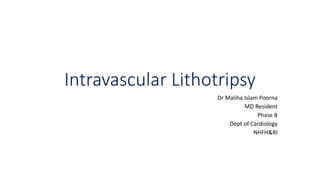
IVL
- 1. Intravascular Lithotripsy Dr Maliha Islam Poorna MD Resident Phase B Dept of Cardiology NHFH&RI
- 2. Coronary artery calcification • The amount of coronary artery calcification increases with age, and the presence of cardiovascular risk factors and comorbidities. • Up to 20% of PCIs are challenged by severe calcifications ( Forero and Daemen, 2019). • Coronary calcifications have been shown to be an independent predictor of PCI failure and future adverse cardiac events. • Lesion calcification increases procedural complexity and time.
- 3. • Coronary artery calcification hinders percutaneous coronary intervention by- Impairment of device crossing Delamination of drug and polymer from stents Alteration of elution kinetics and drug delivery, and Impairment of stent apposition and expansion.
- 4. • Several techniques to treat calcified lesions in native coronary arteries are available, including- High pressure non compliant balloon dilatation Speciality balloons ( scoring, cutting, ultra high pressure) Atherectomy ( both rotational and orbital) • However, all of these techniques have significant limitations.
- 5. Intravascular lithotripsy (IVL)... Intravascular lithotripsy is a novel technique based on an established treatment strategy for renal calculi, in which multiple lithotripsy emitters mounted on a traditional catheter platform deliver localized pulsatile sonic pressure waves to circumferentially modify vascular calcium ( Ali et al, 2019).
- 6. IVL device • The coronary IVL catheter is a single-use, sterile, disposable catheter that contains multiple lithotripsy emitters enclosed in an integrated balloon. • The emitters generate sonic pressure waves in the shape of a sphere creating a field effect to treat vascular calcium. • The generated sonic pressure waves selectively disrupt and fracture calcium in situ, altering vessel compliance while minimizing injury and maintaining integrity of the vessel wall.
- 7. • The IVL catheter is available in 2.5 to 4 mm in diameters & 12 mm in length. • The IVL catheter is connected via a connector cable to the generator that is preprogrammed to deliver 10 pulses in sequence at a frequency of 1 pulse/s for a maximum of 80 pulses per catheter.
- 9. Advantages of IVL over Atherectomy or specialty balloons: • Unlike atherectomy, IVL requires no specific training as the IVL device is delivered similar to standard catheter-based PCI. • IVL therapy is balloon based,and,therefore the risk of atheromatous embolization may be lower than free debulking devices.
- 10. Advantages of IVL over Atherectomy or specialty balloons: • Plaque modification using IVL is not subject to guideware bias, instead, energy is distributed uniformly across the lithotripsy emitter addressing calcium irrespective of its circumferential location. • Unlike traditional balloon technology, which is dependant on static barometric pressure, IVL delivers circumferential ultrashort pulses of high-intensity acoustic energy results in effective circumferential modification of calcific atheroma.
- 11. Advantages of IVL over Atherectomy or specialty balloons: • IVL is typically performed at low atmospheric pressure balloon inflation & thus minimizing mechanical vascular trauma, in contrast to standard & specialty balloons which are inflated at high atmospheric pressure to modify calcium. • Side-branch protection using a guidewire may be easily performed using IVL, without risk of wire entrapment or severing as may occur with rotational or orbital atherectomy.
- 12. Studies on coronary intravascular lithotripsy Disrupt CAD I study- it was a prospective, multicenter, single arm study, which demonstrated the feasibility of IVL for modification of severe coronary artery calcification. Disrupt CAD II study- it was also a prospective, multicenter, single arm study, conducted at 15 hospitals in 9 countries, on 120 patients, carried out between May 2018 and March 2019. It concluded that, in patients with severe coronary artery calcification who require revascularization, IVL was safely performed, with high procedural success and minimal complications and resulted in substantial calcific plaque fracture in most lesions.
- 13. IVL at NHF...
- 14. **References: Forero MN, Daemen J. The coronary intravascular lithotripsy system. Interventional Cardiology Review 2019; 14(3):174-81 Brinton TJ, Ali ZA, Hill JM et al. Feasibility of shockwave coronary intravascular lithotripsy for the treatment of calcified coronary stenoses. Circulation 2019; 139: 834-36 Ali ZA, Nef H, Escaned J. Safety and effectiveness of coronary intravascular lithotripsy for treatment of severely calcified coronary stenoses. Circ Cardiovasc Interv. 2019; 12:e008434